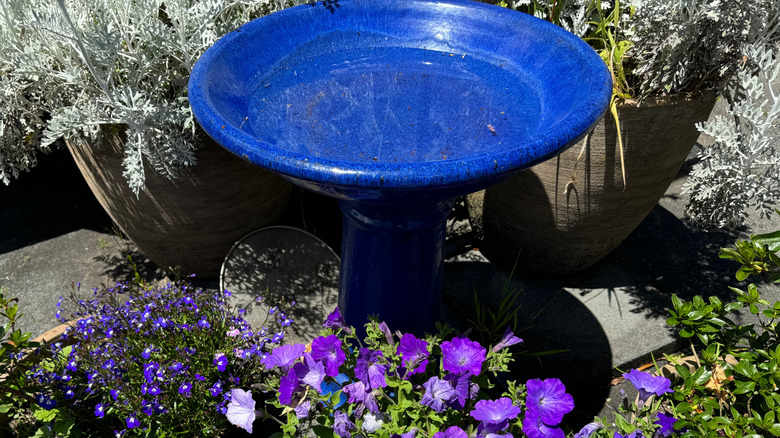The Crucial Mistake You're Making When Choosing A Bird Bath
When you have a bird feeder but no birds, it makes sense to change the birdseed blend or the feeder type. Bird baths can be the same way! If your bird bath has been sitting unused in your yard, the issue might not be where you placed it, but the kind of bath you chose in the first place. One of the most common mistakes bird lovers make is choosing looks over function and picking a bird bath that's too deep, too slippery, or just not bird-friendly. While a big ceramic basin might look beautiful in your garden, it can actually feel intimidating for birds, especially small species. Large and deep bowls may even pose a drowning risk for tinier birds, especially if the surface is slick or the edges are too steep for them to perch on. So while it may look enticing to you, your fancy bird bath could be scaring off your avian visitors.
If your goal is to create a welcoming oasis for all kinds of birds, understanding their preferences is key. Choosing the wrong bird bath doesn't just waste your money; it can unintentionally limit your backyard's biodiversity. Birds are sensitive creatures, and something as simple as the depth or texture of a bath can dictate whether they stay or skip your yard entirely. The good news is that this a simple fix that can transform your outdoor space into a lively, chirping haven.
Choose a bird bath size and style to suit local wildlife
Start by selecting a bird bath that's shallow, textured, and ideally has more of a gradual slope. Concrete, stone, or plastic with a matte finish is often more inviting than smooth metal or glossy resin. Think of it like designing a pool for birds — easy in, easy out, and safe to linger. Consider having two types of bird baths: a small, shallow dish for your local songbirds and a deeper option for larger birds like doves or jays. Another option is choosing your bird bath based on which species frequent your area most. Small birds like finches, chickadees, and wrens prefer shallow water (around 1 to 2 inches deep) and gentle edges where they can perch safely. If you already own a deep bird bath, toss in a few large rocks to help birds perch and feel more secure. Pollinators will appreciate this too! A good bird bath is a start, but don't forget to practice genius tricks that will keep your birth bath clean.
To tailor your setup, observe which birds visit your yard or use an app like Cornell's Merlin Bird ID or eBird to identify common species in your region. This gives you insight into what bird bath depth, size, and materials will be most appealing. A thoughtfully chosen bird bath can dramatically improve your backyard's activity, beauty, and ecological balance. If you want even more variation, you might consider a ground birdbath, but there are a few things you should know about ground birdbaths, both good and bad.

